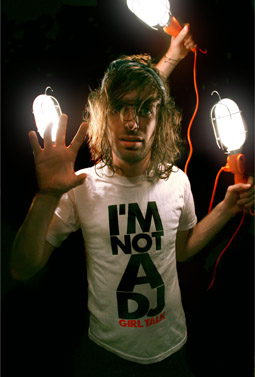keeping the (on)line open
ross harley: open video conference, new york

RiP: A Remix Manifesto, Brett Gaylor with Girl Talk at Concert in Montreal, Nov 13, 2008
photo Kat Baulu, copyright National Film Board of Canada
RiP: A Remix Manifesto, Brett Gaylor with Girl Talk at Concert in Montreal, Nov 13, 2008
VIDEO IS EVERYWHERE ON THE WEB THESE DAYS. THE PROBLEM IS THAT WHILE VIDEO IS ARGUABLY THE MOST INFLUENTIAL MEDIUM, IT’S ALSO THE MOST “CLOSED” ONLINE MEDIUM—THE CODECS AND SITES WE USE TO SHARE MANY OF OUR VIDEOS ARE MOSTLY OWNED BY GLOBAL CORPORATIONS (THINK ADOBE’S FLASH, APPLE’S QUICKTIME, OR THE COMMERCIALLY SUPPORTED VIDEO STREAMING SITE HULU).
While Google-scale entities like YouTube have grown to become the default state of online video, many critics, artists and activists are now wary of the proprietary systems that underlie their operations. As large corporations stake out more and more of the technological platforms needed to deliver video online, critics ask whether there is a danger that the ubiquitous, “free” and interoperable characteristics we find in email, wikis and blogs will also apply to online video. Many fear the worst.
Earlier this year in New York, a coalition of organisations and individuals met to discuss the dilemmas faced by many developers and content creators who have an interest in the newly emerging marriage of the open web and online video culture. Organised by the Open Video Alliance, the event brought together a wide range of people interested in creating and promoting free and open technologies, policies, and practices in online video (ongoing information can be found at their website http://openvideoalliance.org).
According to many of the presenters and participants, we have reached an important fork in the road. In the long-tail economy of the digital era, web-delivered video could easily become a glorified TV-on-demand service, and a central component of a permissions-based culture. Each time we want to exchange, upload or download a video file, we need to ask permission to use the codecs and protocols that allow us to share the video.
That’s why many of the independent producers and activists gathered at this event suggested that the values of transparency, interoperability and decentralisation in online video must be seriously considered if we are to avoid a hyper-commercialised hijacking of the web’s participatory culture.
Well-known figures such as Yochai Benkler and Jonathan Zittrain (from Harvard’s Berkman Center), Xeni Jardin (co-editor of Boing Boing) and Brett Gaylor (director of RiP: A Remix Manifesto) were among the presenters arguing for a more open and transparent online video culture. Benklers’ well-known work on participatory culture, distributed innovation and distributed creativity also finds its way into this emerging concept of open video. Citing mashup artists like Blacklantern, (www.theblacklantern.com), popular videos such as Let’s Bomb Iran and Jonathan Coulton’s Code Monkey as instances of decentralised human capability, Benkler’s exemplars also point to the inescapable contradictions: none of these works could have existed without YouTube.
But they could just as easily exist in other more open platforms. Michael Dale, a senior developer from the open source online video platform Kaltura, has been working on just such a project, entitled Metavid. It’s a wiki-based community archive project that hosts public domain legislative footage from the US Congress, and allows users to access metadata (such as transcripts) in order to reuse the footage in mashups or for political research. While it started as a small project by artists, it soon became a massively popular repository of political video.
Dale sees the Kaltura project as “the Apache of open video.” And that says a lot to many from the burgeoning online video community. (Apache is one of the leading open source foundations, run on a collaborative, consensus based development process. It offers an open and pragmatic software licence for high quality software that is collectively produced.)
Based on Wikimedia principles, Kaltura is a big proponent of the push towards non-Flash video standards. Dale reminded us that Wikipedia’s enormous success is largely due to its simple browser-based editing, which has removed the barriers to participation. The new HTML5 specification (which is the next major revision of the core mark-up language of the web) similarly allows open source codecs (such as OGG Theora) to play natively within the browser and to be accessible to anyone without having to use proprietary codes and players.
While this may not seem like much of a big deal, it means the world to many in the emergent open video community. One of the aims of open video is to decouple the video from the player, which is now possible with HTML5. In other words, why do we need to ask Adobe’s permission to download their Flash player or Apple for Quicktime to watch a movie on the web, when HTML 5 and OGG can do it for “free”?

Greg Gillis aka Girl Talk
photo Andrew Strasser, copyright EyeSteelFilm
Greg Gillis aka Girl Talk
Some view this open source approach as a little utopian, even evangelical at times. For people working in public institutions or archives that need to guarantee broad ‘universal’ access to their digital collections, non-proprietary open video standards are essential. But there’s also a business case to be made. Open standards (like HTML) can drive innovation and build markets. They also add public value, as the more open video becomes, the more social value is created.
Perhaps most importantly, open video raises questions about who will control and define the social and economic spaces that are emerging around online video. Will we see a repeat of the major structure of corporate television on the web, or can we shape the world ourselves, and insist on openness at every level?
The following projects represent the beginnings of this nascent movement:
Xiph, www.xiph.org, a non-profit corporation dedicated to protecting the foundations of internet multimedia from control by private interests.
Kaltura, http://corp.kaltura.com, an open source online video platform.
Miro, www.getmiro.com/blog, an on-profit video player and podcast client built on open source principles.
Opencast, www.opencastproject.org, an initiative driven by higher education institutions to empower them to make informed choices about capture, processing, and distribution infrastructure for audio/video.
MythTV, www.mythtv.org, a free open source digital video recorder (DVR) project distributed under the terms of the GNU GPL.
Metavid, http://metavid.org/blog, Abram Stern and Michael Dale’s open video archive of US Congress footage.
Utagit, http://utag.it, a free software web service that provides spontaneous, rich, multi-dimensional tagging of media streams.
Metabroadcast, http://metabroadcast.com, a London-based start-up that develops video distribution software.
OpenImages, www.ohloh.net/p/openimages, a platform to upload, edit and publish video, audio and images.
TransmissionCC, www.transmission.cc, a network of citizen journalists, video makers, artists, researchers, programmers and web producers who are developing online video distribution tools for social justice and media democracy.
Open Video Conference, New York, Vanderbilt Hall, NYU Law, June 19-20; http://openvideoalliance.org/blog
RealTime issue #93 Oct-Nov 2009 pg. 26






